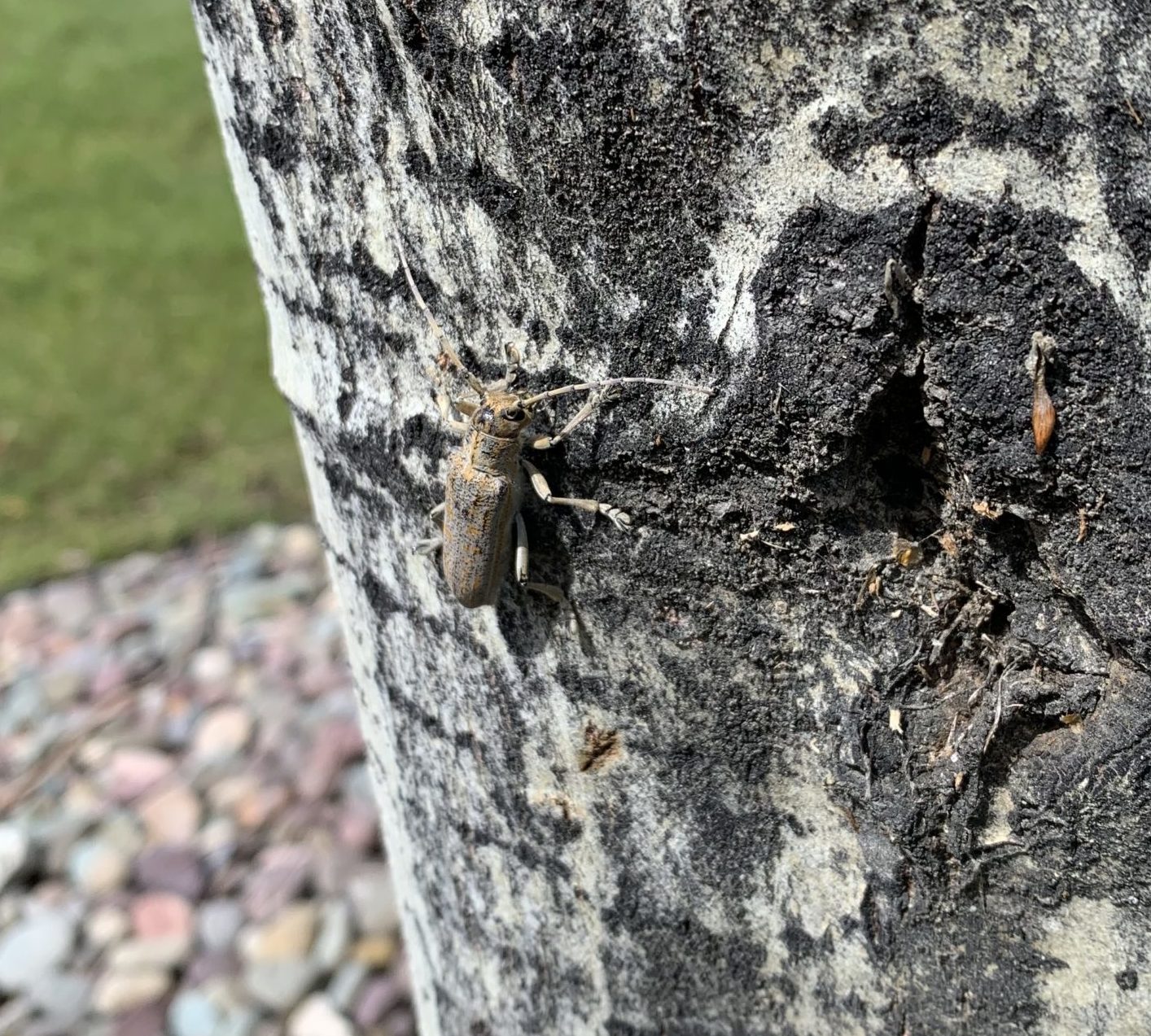Trees get bored too
One of the most common tree removals our crews do in Edmonton are aspens. Not because they are bad trees but because a nasty critter makes these beautiful trees dangerous.
Every year large aspens suddenly fail in the wind and when the damage is assessed we find the breakage point is riddles with holes and decay. Most problematic of these occurrences are from columnar aspens because they are often planted near parking lots where perfect targets wait below. Why are the aspen trees dying off so quickly? How can we stop it? Well Kentucky Blue Grass has the answers.
The Problem
Poplar Borer or Saperda Calcarata is a major pest in Alberta that is ruining our aspen trees, most of all our columnar aspen trees. This little horned beetle targets healthy trees to lay its eggs in. The adult beetles feed on a trees leaves and shoots until they mate, then the female cuts small slits into the bark to lay a single egg in each. To help her larvae stay warm she targets exposed stems large enough for the young to survive their full life cycle, usually a stem 4 inch diameter or larger. After two weeks the larvae hatch and begin feeding on the sapwood of the tree. Sometimes eating all the way around the trunk and cutting of nutrient supply to everything above it. The larvae will eventually bore into the heartwood core of the tree to build their pupil cells. These cells at the bottom of their tunnels are where they pupate into the adult beetle and emerge in the spring.
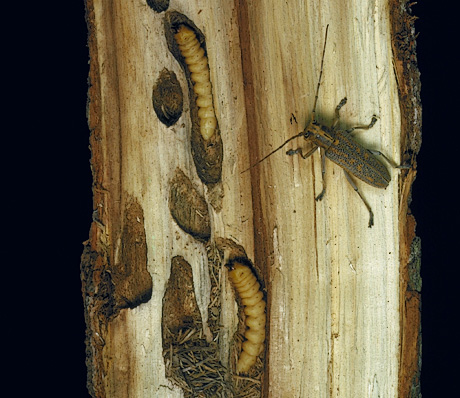
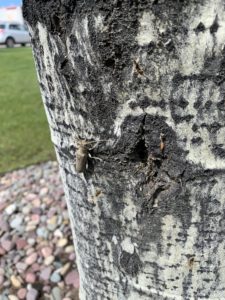
Borer rarely kills the tree on its own. Bored out trees soon become compromised both in structural integrity and their ability to fend off fungus. The galleys created by borer become breeding grounds for decay and this is what usually takes the tree. Trees that are heavily infested with borer are called brood trees and are most likely to fail in the wind.

What trees are Targeted?
The poplar borer targets all trees of the genus Populus. The Populus genus is in the willow family and includes aspens and cottonwoods. In Alberta, our columnar and trembling aspens are the main targets. It is hard to find mature Swedish columnar aspen trees without the tell-tale symptoms of borer activity. The borer prefers trees that get direct sunlight to stay warm. This makes urban planted aspens ideal as they often have gaps in their foliage due to clearance issues. Trees with thick foliage will become bored at their base where no branches grow.
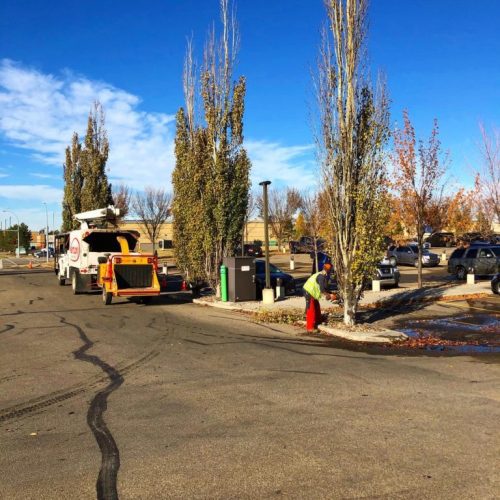
The Symptoms
- Borer evidence is easy to spot. When the borer enters and leaves the tree, they create holes where sap will bleed out, staining the area directly below the hole a dark brown or even black.
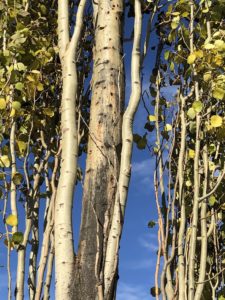

- The holes often have Frass coming out of them. Frass is a reddish-brown clump of sawdust. Frass is composed of wood shavings and borer feces.
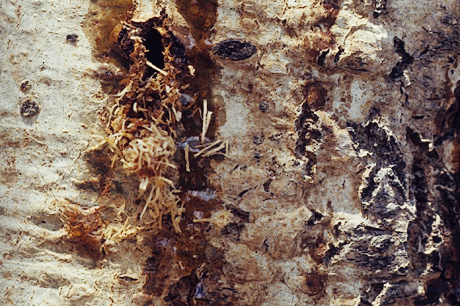
- When the tree develops a more significant infestation the frass will litter the tree base, drying to look like very fine sawdust.
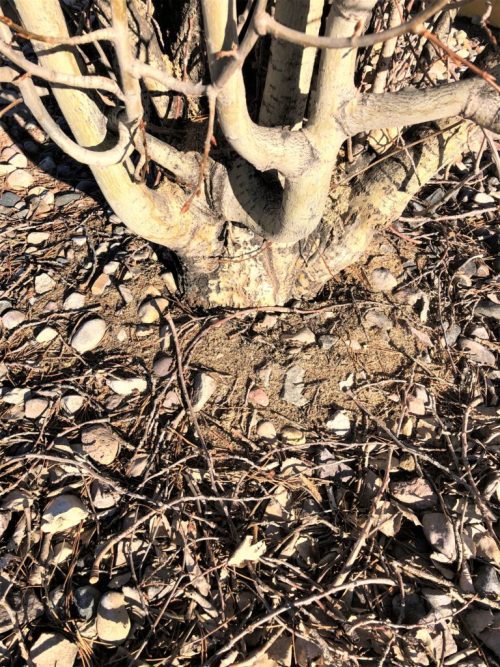
What can be done?
You have some options when you identify borer within your tree.
If the tree is bored out to the point it is a risk, then arborists will recommend removing the tree. Especially if one is bored while others are not. Removing the brood tree will improve the other trees chances of avoiding the borer.
The most effective but most difficult option is to individually fill each hole with insecticide. This requires access to the whole tree and can be painstaking slow. If some holes are missed, then the borer will continue to infect the tree. This method is very expensive due to the difficulty in accessing the entire tree up close. Just spraying the tree for borer is not recommended because it will not kill the borer already inside the tree, nor will it protect the tree from future attacks.
Another option is insecticide treatments. These treatments are applied annually or every couple years and make the entire trees sapwood toxic to wood borer. This will kill any borer entering or leaving the tree but will not kill those pupating inside. This method is far less expensive that trying to treat each borer galley individually.
How to prevent Borer damage
First and foremost, the best way to prevent significant borer damage is proper placement of your trees and keeping them healthy. It is best to place aspens where their exposed bark will be shaded. This can be done by placing other small plants around their base to provide a barrier. It’s important to note that aspen trees need direct sunlight so it is not advised to plant them in completely shaded areas. Shade their base and keep them healthy. A healthy tree will grow thicker foliage to protect its trunk. A healthier tree will also have a better ability to survive despite wood borer.
Treating the trees with insecticide before they are targeted is your best option. If a healthy tree loses a limb and the trunk is exposed, then it can become a target. Just because the tree is shaded does not mean it will not become targeted. It will just be a less likely target. If the tree is made toxic to wood borer before it is ever targeted, then the borer will not be able to enter the tree.
Borer is easy to spot when they leave the tree as an adult but nearly impossible during the first 2-5 years of infestation. This is why we advise treating aspens before they have borer damage because after is sometimes too late.
Kentucky Landscape has a lot of success in treating for wood borer with an average rate of protecting 8 out of 10 trees. We apply this treatment in the early spring and fall when the tree is trans locating the most. Trans locating is when the tree is moving fluids and nutrients up and down its trunk. To keep the trees protected we usually treat them annually. Contact us for a free quote!
Referenced Professional
Denise Allen, ISA Certified Master Arborist, April 30 2020
References
Hugh Philip & Ernest Mengerson, University of Alberta, “Insect Pests of the Prairies”
W.G.H Ives & H.R Wong, Government of Canada Canadian Forestry Service, “Tree and shrub insects of the prairie provinces”


